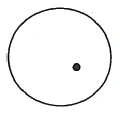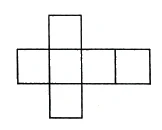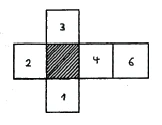The Fourth Dimension
GA 324a
Four-Dimensional Space
7 November 1905, Berlin
Our ordinary space has three dimensions—length, width, and height. A line has only one dimension, length. This blackboard is a plane, that is, it has two dimensions, length and width. A solid object encompasses three dimensions. How does a three-dimensional figure arise?
Imagine a figure with no dimensionality at all, namely, the point. It has zero dimensions. When a point moves in a constant direction, a straight line, or one-dimensional figure, results. Now visualize the line moving. The result is a plane, which has length and width. And, finally, a moving plane describes a three-dimensional figure. We cannot continue this process, however. We cannot use movement to create a four-dimensional figure or a fourth dimension from a three-dimensional object. How can we use images to develop a concept of the fourth dimension? Some mathematicians and scientists—Zöllner, for example—have felt tempted to bring the spiritual world into harmony with our sense-perceptible world by assuming that the spiritual world exists in four-dimensional space. [Note 60]

Imagine a circle, a completely closed figure lying in a plane. Suppose that someone asks us to move a coin into the circle from outside. We must either cross the circumference of the circle (Figure 46) or—if we are not allowed to touch the circumference—pick up the coin, lift it into space, and place it inside the circle, which requires leaving the second dimension and entering the third. To move a coin magically into a cube or a sphere, we must leave the third dimension and pass through the fourth. [Note 61] In this lifetime, I first began to grasp the nature of space when I began to study modern synthetic, projective geometry and understood the significance of transforming a circle into a line (Figure 47). The world is revealed in the soul's subtlest thoughts. [Note 62]

Now let's imagine a circle. We can trace its circumference all the way around and return to our original starting point. Let's picture the circle growing bigger and bigger while a tangent line remains constant. Since the circle is growing increasingly flat, it will eventually become a straight line. When I trace these successively larger circles, I always go down on one side and come back up on the other before returning to my starting point. Ultimately, I move in one direction—let's say to the right—until I reach infinity. Thus, I must return from infinity on the other side, from the left, since the sequence of points in a straight line behaves just like a circle. So we see that space has no end, just as a straight line has no end, since its points are arranged just like those in a closed circle. Correspondingly, we must imagine the infinite expanse of space as self-contained, like the surface of a sphere. We have now depicted infinite space in terms of circles or spheres. This concept will help us conceive the reality of space. [Note 63]
Instead of imagining ourselves proceeding mindlessly toward infinity and returning unchanged from the other direction, let's imagine that we carry a light. As seen from a constant point on the line, this light becomes ever weaker as we carry it away and ever stronger as we return with it from infinity. If we then picture the changes in the intensity of the light as positive and negative, we have positive on one side, where the light grows stronger, and negative on the other. We find these two poles, which are simply the opposite effects of space, in all effects in the natural world. This thought leads to the concept of space as possessing force,—the forces at work in space are simply manifestations of force itself. We will no longer doubt the possibility of discovering a force that works from within in three-dimensional space, and we will realize that all spatial phenomena are based on actual relationships in space.
One such relationship is the intertwining of two dimensions. To make two closed rings interlock, you must open one of them in order to insert the other. I will now convince myself of the inherent manifoldness of space by twisting this figure, a rectangular strip of paper, twice—that is, I secure one end while rotating the other end 360°. I then hold the two ends together, securing the strip with pins. Cutting this twisted ring in half lengthwise results in two interlocking rings that cannot be separated without breaking one of them. Simply twisting the strip made it possible to perform an operation in three dimensions that can otherwise be carried out only by entering the fourth dimension. [Note 64] This is not just a game,—it is cosmic reality. Here we have the Sun, the Earth's orbit around the Sun, and the Moon's orbit around the Earth (Figure 48). Because the Earth moves around the Sun, the orbits of the Moon and Earth are just as intertwined (as our two rings of paper). In the course of Earth's evolution, the Moon broke away from the Earth. This separation occurred in the same way as the interlocking of our two rings of paper. When we look at space in this way, it becomes inherently alive.

Next, consider a square. Imagine it moving through space until a cube has been described. The square's movement must be perpendicular to its original location. A cube consists of six squares that form its surface. To give you an overview of a cube, I can lay the six squares down beside each other in a plane (Figure 49). I can reconstruct the cube by folding these squares upward, moving them into the third dimension. The sixth cube lies on top. To form this cross-shaped figure, I broke the cube down into two dimensions. Unfolding a three-dimensional figure transforms it into a two-dimensional figure.

As you see, the boundaries of a cube are squares. A three-dimensional cube is always bounded by two-dimensional squares. Let's look at a single square. It is two-dimensional and bounded by four one-dimensional line segments. I can lay these four line segments out in single dimension (Figure 50). The edges defining one of the square's dimensions are colored red solid lines, and the other dimension is colored blue dotted lines. Instead of saying length and width, I can talk about the red and blue dimensions.

I can reconstruct a cube from six squares. That is, I go beyond the number four (the number of line segments forming the edges of a square) to the number six (the number of planes forming the sides of a cube). Taking this process one step further, I move from six to eight (the number of cubes forming the "sides" of a four-dimensional figure). I arrange the eight cubes to form the three-dimensional counterpart of the earlier figure, which consisted of six squares, in the two-dimensional plane (Figure 51).

Now, imagine that I can turn this figure inside out, fold it up, and put it together so that the eighth cube closes off the entire figure. I use eight cubes to create a four-dimensional figure in four-dimensional space. Hinton calls this figure a tessaract. Its boundaries consist of eight cubes, just as the boundaries of an ordinary cube consist of six squares. Thus, a four-dimensional tessaract is bounded by eight three-dimensional cubes. Envision a being that can see only in two dimensions. When this being looks at the unfolded squares of a cube, it sees only squares 1, 2, 3, 4, and 6, but never square 5, the shaded square in the middle (Figure 52). Something similar is true when you yourself look at an unfolded four-dimensional object. Since you can see only three-dimensional objects, you can never see the hidden cube in the middle.

Picture drawing a cube on the board like this, so that the outline of a regular hexagon appears. The rest of it is hidden behind. What you see is a shadow image of sorts, a projection of the three-dimensional cube into two-dimensional space (Figure 53). The cube's two-dimensional shadow image consists of rhombuses or equilateral parallelepipeds. If you imagine the cube made of wire, you can also see the rhombuses in the back. This projection shows six overlapping rhombuses. In this way, you can project the entire cube into two-dimensional space.

Now imagine our tessaract in four-dimensional space. Projecting this figure into three-dimensional space must yield four oblique cubes (parallelepipeds) that do not interpenetrate. One of these rhombic oblique cubes would be drawn like this (Figure 54).

Eight such oblique rhombic cubes, however, must interpenetrate in order to yield a complete three-dimensional image of a four-dimensional tessaract in three-dimensional space. We can depict the complete three-dimensional shadow of a tessaract with the help of eight suitably interpenetrating rhombic cubes. The resulting spatial figure is a rhombic dodecahedron with four diagonals (Figure 55). In our rhombic projection of a cube, three adjacent rhombuses coincide with the other three so that only three of the six surface cubes are visible. Similarly, in the rhombic dodecahedron projection of a tessaract, only four non-interpenetrating rhombic cubes are visible as the projections of the tessaract's eight boundary cubes, since four adjacent rhombic cubes completely cover the remaining four. [Note 65]

Thus we can construct a tessaract's three-dimensional shadow, though not the four-dimensional object itself. Similarly, we our74 selves are shadows of four-dimensional beings. When we move from the physical to the astral plane, we must cultivate our capacity to form mental images. Picture a two-dimensional being repeatedly attempting to imagine vividly such a three-dimensional shadow image. Mentally constructing the relationship of the third dimension to the fourth fosters inner forces that will permit you to see into real, not mathematical, four-dimensional space.
We will always remain powerless in the higher world if we do not develop faculties that permit us to see in the higher world here, in the world of ordinary consciousness. The eyes we use for seeing in the physical, sense-perceptible world develop when we are still in the womb. Similarly, we must develop supersensory organs when we are still in the womb of the Earth so that we can be born into the higher world as seers. The development of physical eyes in utero is an example that illuminates this process.
A cube must be constructed by using the dimensions of length, width, and height. A tessaract must be constructed by using the same dimensions with the addition of a fourth. Because it grows, a plant breaks out of three-dimensional space. Any being that lives in time frees itself from the three ordinary dimensions. Time is the fourth dimension. It remains invisible within the three dimensions of ordinary space and can be perceived only with clairvoyant powers. A moving point creates a line, a moving line creates a plane, and a moving plane creates a three-dimensional figure. When three-dimensional space moves, the result is growth and development. There we have four-dimensional space, or time, projected into three-dimensional space as movement, growth, and development.
You will find that our geometric thoughts on building up the three ordinary dimensions continue into real life. Time is perpendicular to the three dimensions and constitutes the fourth dimension. It grows. When time is enlivened within a being, sensory ability arises. When time is multiplied internally within a being so that self-movement takes place, the result is a sensate animal being. In reality, such a being has five dimensions, while a human being has six. We have four dimensions in the ether realm (astral plane), five dimensions in the astral realm (lower devachan), and six dimensions in upper devachan. Thus, the various manifestations of the spirit emerge in you. When devachan casts its shadow into astral space, the result is our astral body. When the astral realm casts its shadow into etheric space, the result is our ether body, and so on. [Note 66]
The natural world dies when time moves in one direction and is re-enlivened when it moves in the other. The two points where these streams meet are birth and death. The future is constantly coming to meet us. If life moved in one direction only, nothing new would ever arise. Human beings also possess genius—that is, their future, their intuitions, streaming toward them. The past that has been worked on is the stream coming from the other side,—it determines the being as it has evolved up to the present time.
See Steiner's lectures of March 24 and 31, 1905, and the relevant notes.
See Note 6, (March 24, 1905).
See Rudolf Steiner's autobiography, Autobiography—Chapters in the Course of my Life (GA 28), chapter III, p. 63, and his lecture of April 3, 1922, "Die Stellung der Anthroposophie in den Wissenschaften" in Damit der Mensch ganz Mensch werde: Die Bedeutung der Anthroposophie im Geistesleben der Gegenwart (GA 82).
In this passage, Rudolf Steiner refers to the distant (or absolute) plane of Euclidean space, resulting in a projective space. A projective space is self-contained and has no limits or boundaries, meaning that we can travel to "infinity" in any direction and return from the other side.
See also the explanation in his lecture of March 24, 1905 and the accompanying notes.
See the explanations at the beginning of the preceding lecture (June 7, 1905) and the accompanying notes.
The upper and lower devachen are heavenly realms through which the soul passes through after death. See Rudolf Steiner's Theosophy.

